 Technology peripherals
Technology peripherals
 AI
AI
 Erase blemishes and wrinkles with one click: in-depth interpretation of DAMO Academy's high-definition portrait skin beauty model ABPN
Erase blemishes and wrinkles with one click: in-depth interpretation of DAMO Academy's high-definition portrait skin beauty model ABPN
Erase blemishes and wrinkles with one click: in-depth interpretation of DAMO Academy's high-definition portrait skin beauty model ABPN
With the vigorous development of the digital cultural industry, artificial intelligence technology has begun to be widely used in the field of image editing and beautification. Among them, portrait skin beautification is undoubtedly one of the most widely used and most demanded technologies. Traditional beauty algorithms use filter-based image editing technology to achieve automated skin resurfacing and blemish removal effects, and have been widely used in social networking, live broadcasts and other scenarios.
However, in the professional photography industry with high thresholds, due to the high requirements for image resolution and quality standards, manual retouchers are still the main productive force in portrait beauty retouching. , complete a series of tasks including skin leveling, blemish removal, whitening, etc. Usually, the average processing time for a professional retoucher to perform skin beautification operations on a high-definition portrait is 1-2 minutes. In fields such as advertising, film and television, which require higher accuracy, the processing time will be longer.
Compared with skin resurfacing in interactive entertainment scenes, advertising-level and studio-level refined skin beautification brings higher requirements and challenges to the algorithm. On the one hand, there are many types of blemishes, including acne, acne marks, freckles, uneven skin tone, etc. The algorithm needs to adaptively process different blemishes; on the other hand, in the process of removing blemishes, the texture of the skin needs to be preserved as much as possible , texture, and achieve high-precision skin modification; last but not least, with the continuous iteration of photographic equipment, the image resolution commonly used in professional photography has reached 4K or even 8K, which poses great challenges to the processing efficiency of the algorithm. Stringent requirements.
Therefore, with the starting point of realizing professional-level intelligent skin beautification, we have developed a set of ultra-fine local image retouching algorithms ABPN for high-definition images. Very good results and applications have been achieved in clothing wrinkle removal tasks.
- ##Paper: https://openaccess.thecvf.com/content/CVPR2022/papers/Lei_ABPN_Adaptive_Blend_Pyramid_Network_for_Real-Time_Local_Retouching_of_CVPR_2022_paper.pdf
- Model & code: https://www.modelscope.cn/models/damo/cv_unet_skin-retouching/summary
##3.1 Traditional beauty algorithm
#The core of the traditional beauty algorithm is to make the pixels in the skin area smoother and reduce the conspicuousness of flaws, thereby making the skin look smoother. Generally speaking, existing beautification algorithms can be divided into three steps: 1) image filtering algorithm, 2) image fusion, and 3) sharpening. The overall process is as follows:

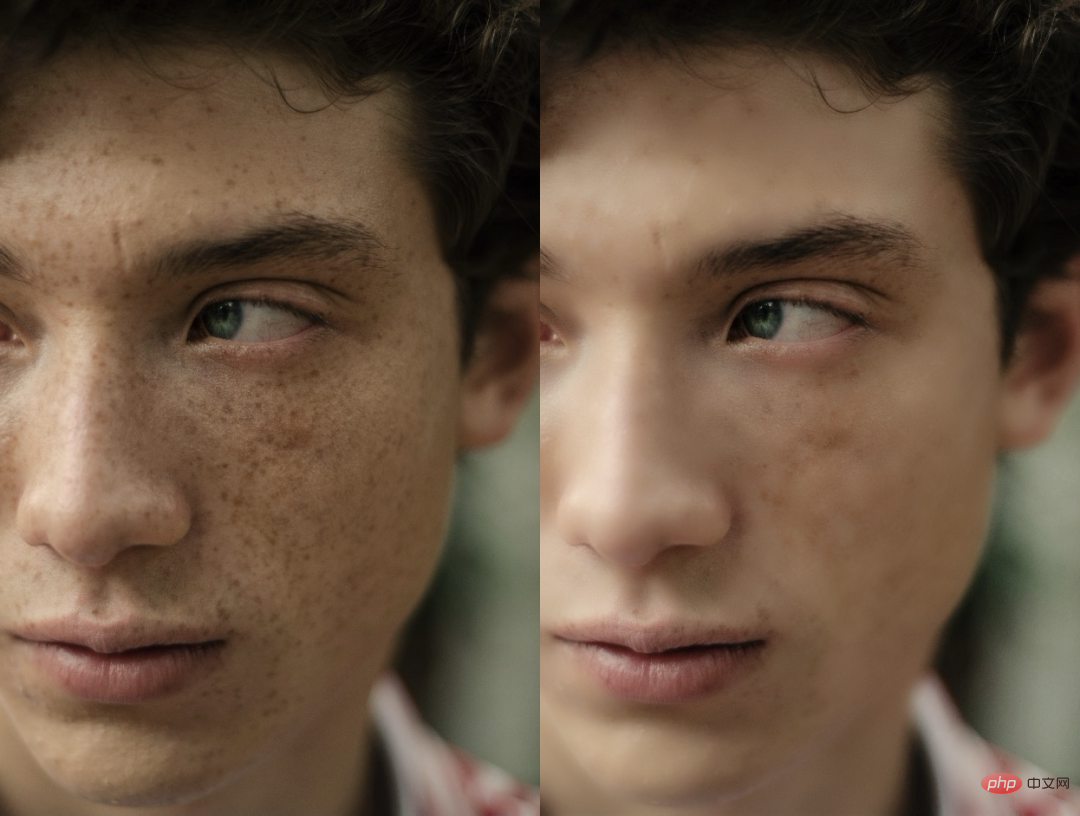
##The original image comes from unsplash [31]From the effect point of view, the traditional beauty algorithm has two major problems: 1) The processing of defects is non-adaptive and cannot handle different types of defects well. 2) Smoothing processing causes the loss of skin texture and texture. These problems are particularly noticeable in high-definition images.
3.2 Existing deep learning algorithm
In order to achieve adaptive modification of different skin areas and different flaws, based on Data-driven deep learning algorithms appear to be a better solution. Considering the relevance of the task, we discussed and compared the applicability of four existing methods: Image-to-Image Translation, Photo Retouching, Image Inpainting, and High-resolution Image Editing for skin beautification tasks.
- 3.2.1 Image-to-Image Translation
Image-to-Image Translation The task was initially started by pix2pix [1 ], which summarizes a large number of computer vision tasks into pixel-to-pixel prediction tasks, and proposes a general framework based on conditional generative adversarial networks to solve such problems. Based on pix2pix [1], various methods have been proposed to solve the image translation problem, including methods using paired images [2, 3, 4, 5] and methods using unpaired images. Methods [6,7,8,9]. Some work focuses on certain specific image translation tasks (such as semantic image synthesis [2, 3, 5], style transfer, etc. [9, 10, 11, 12]) and has achieved impressive results. However, most of the above image translations mainly focus on the overall transformation of image to image and lack attention to local areas, which limits their performance in skin beautification tasks.
- 3.2.2 Photo Retouching
##Benefiting from the development of deep convolutional neural networks, learning-based methods[ 13,14,15,16] has shown excellent results in the field of image retouching in recent years. However, similar to most image translation methods, existing retouching algorithms mainly focus on manipulating some overall properties of the image, such as color, lighting, exposure, etc. Little attention is paid to the retouching of local areas, and skin retouching is exactly a local retouching task (Local Photo Retouching), which requires retouching the target area while keeping the background area unchanged.
- 3.2.3 Image Inpainting
- 3.2.4 High-resolution Image Editing
Local retouching framework based on adaptive blending pyramid
The essence of skin beauty lies in the editing of images. Unlike most other image conversion tasks, this Editing is partial. Similar tasks include wrinkle removal on clothing and product modification. This type of local image retouching task has strong commonality. We summarize its three main difficulties and challenges: 1) Accurate positioning of the target area. 2) Local generation (modification) with global consistency and detail fidelity. 3) Ultra-high resolution image processing. To this end, we propose a local retouching framework based on Adaptive Blend Pyramid (ABPN: Adaptive Blend Pyramid Network for Real-Time Local Retouching of Ultra High-Resolution Photo, CVPR2022,[27]) to achieve ultra-high resolution For refined local retouching of images, we will introduce its implementation details below.
4.1 Overall network structure
As shown in the figure above, the network structure mainly consists of two parts: context-aware local modification layer (LRL) and adaptive blending pyramid layer (BPL). The purpose of LRL is to locally modify the downsampled low-resolution image and generate a low-resolution modification result image, fully considering the global context information and local texture information. Further, BPL is used to gradually upscale the low-resolution results generated in LRL to high-resolution results. Among them, we designed an adaptive blending module (ABM) and its reverse module (R-ABM). Using the intermediate blending layer Bi, we can achieve adaptive conversion and upward expansion between the original image and the result image, showing a powerful scalability and detail fidelity capabilities. We conducted a large number of experiments in the two data sets of facial modification and clothing modification, and the results show that our method is significantly ahead of existing methods in terms of effectiveness and efficiency. It is worth mentioning that our model achieves real-time inference of 4K ultra-high-resolution images on a single card P100. Below, we introduce LRL, BPL and network training loss respectively.
4.2 Context-aware Local Retouching Layer
In LRL, we Want to solve the two challenges mentioned in Part 3: precise positioning of the target area and local generation with global consistency. As shown in Figure 3, LRL consists of a shared encoder, mask prediction branch (MPB), and local modification branch (LRB).


In general, we use a multi-tasking structure to achieve explicit target areas Prediction,guidance with local modification. Among them, the structure of the shared encoder can use the joint training of the two branches to optimize features and improve the modification branch's global semantic information and local perception of the target. Most image translation methods use the traditional encoder-decoder structure to directly implement local editing without decoupling target positioning and generation, thus limiting the generation effect (the capacity of the network is limited). In contrast, multi-branch structures It is more conducive to task decoupling and mutual benefit. In the local modification branch LRB, we designed LAM (Figure 4), which uses the spatial attention mechanism and the feature attention mechanism simultaneously to achieve full fusion of features and capture of the semantics and texture of the target area. The ablation experiment (Figure 6) demonstrates the effectiveness of each module design.
4.3 Adaptive Blend Pyramid Layer
LRL is implemented at low resolution For local retouching, how to extend the retouching results to high resolution while enhancing its detail fidelity? This is the problem we want to solve in this part.
- 4.3.1 Adaptive Blend Module
##In the field of image editing, blending layers (Blend layer) is often used to mix with the image (base layer) in different modes to achieve various image editing tasks, such as contrast enhancement, deepening, and lightening operations, etc. Usually, given a picture , and a blending layer 
 , we can blend the two layers to get the image editing result , as follows:
, we can blend the two layers to get the image editing result , as follows: 

where f is a fixed pixel-by-pixel mapping function, usually determined by the blending mode. Limited by the conversion capability, a specific blending mode and fixed function f are difficult to be directly applied to a variety of editing tasks. In order to better adapt to the distribution of data and the conversion modes of different tasks, we drew on the soft light mode commonly used in image editing and designed an adaptive blending module (ABM), as follows:

represents Hadmard product, and are learnable parameters, which are used by all ABM modules in the network and the following Shared by the R-ABM module, represents a constant matrix with all values 1.
- 4.3.2 Reverse Adaptive Blend Module
, in order to obtain the hybrid layer B, we solve formula 3 and construct a reverse adaptive blending module (R-ABM), as follows:

In general, by using the mixed layer as an intermediary, the ABM module and the R-ABM module realize the adaptive conversion between the image I and the result R. Compared with directly using convolution on the low-resolution result Upsampling and other operations are expanded upward (such as Pix2PixHD). We use the hybrid layer to achieve this goal, which has two advantages: 1) In the local modification task, the hybrid layer mainly records the local part between the two images. Transform information, meaning it contains less irrelevant information and is easier to optimize by a lightweight network. 2) The blending layer acts directly on the original image to achieve the final modification, which can make full use of the information of the image itself, thereby achieving a high degree of detail fidelity.

In fact, there are many alternative functions or strategies for the adaptive hybrid module. We discuss the design motivation and other solutions in the paper. The comparison is introduced in detail and will not be elaborated here. Figure 7 shows the ablation comparison between our method and other hybrid methods.
4.3.3 Refining Module
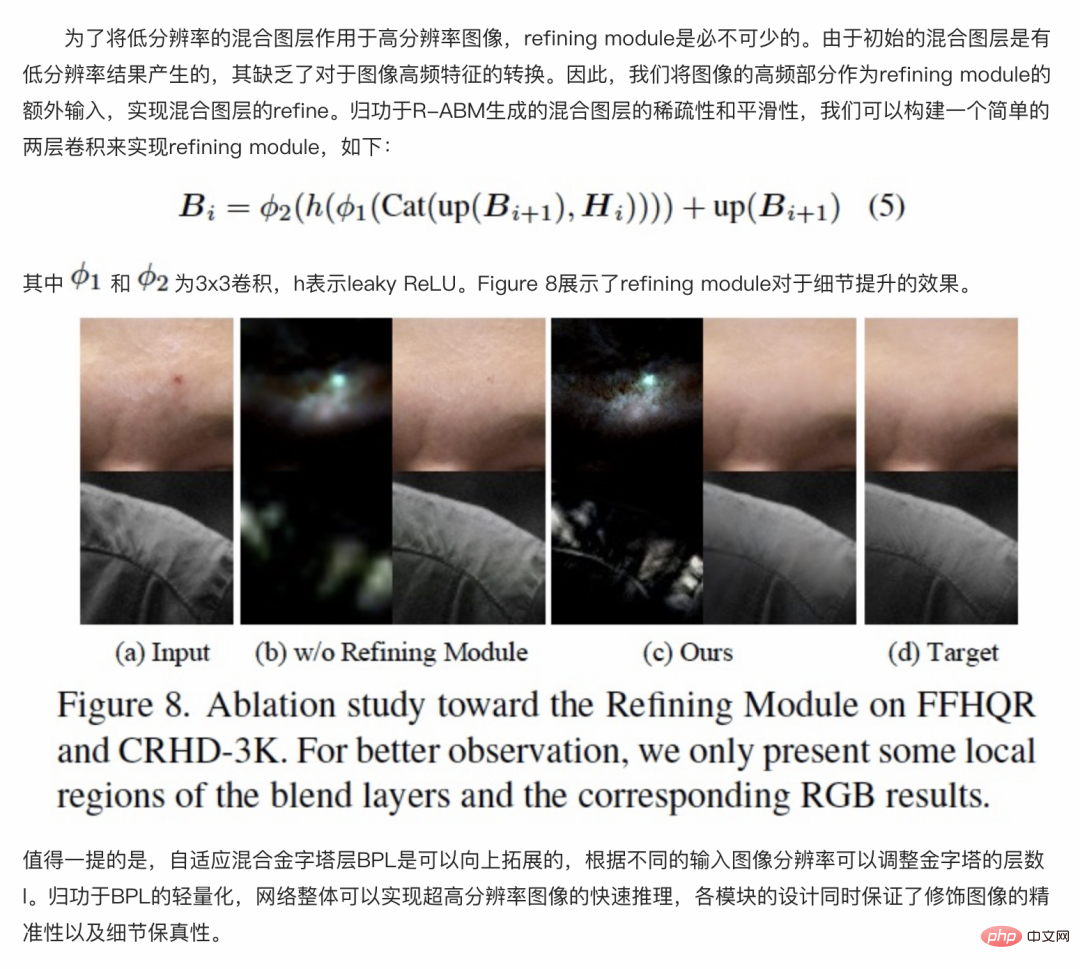
##4.4 Loss function

5.1 Comparison with SOTA method

5.2 Ablation experiment
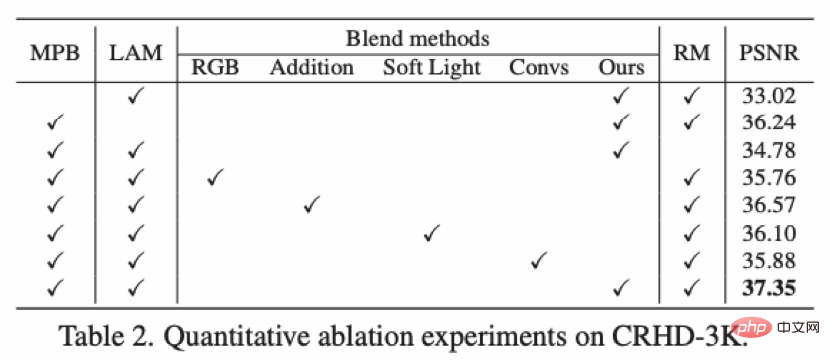
##5.3 Running speed And memory consumption
 Effect display
Effect display
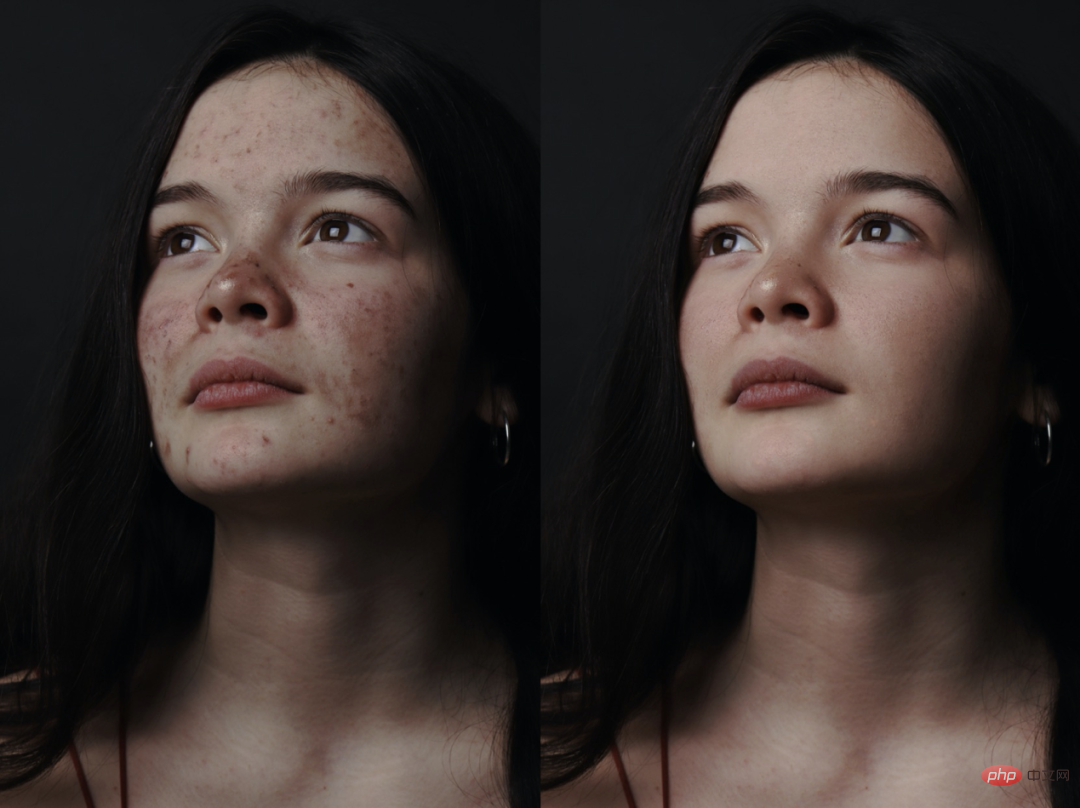
Original image from unsplash [31]
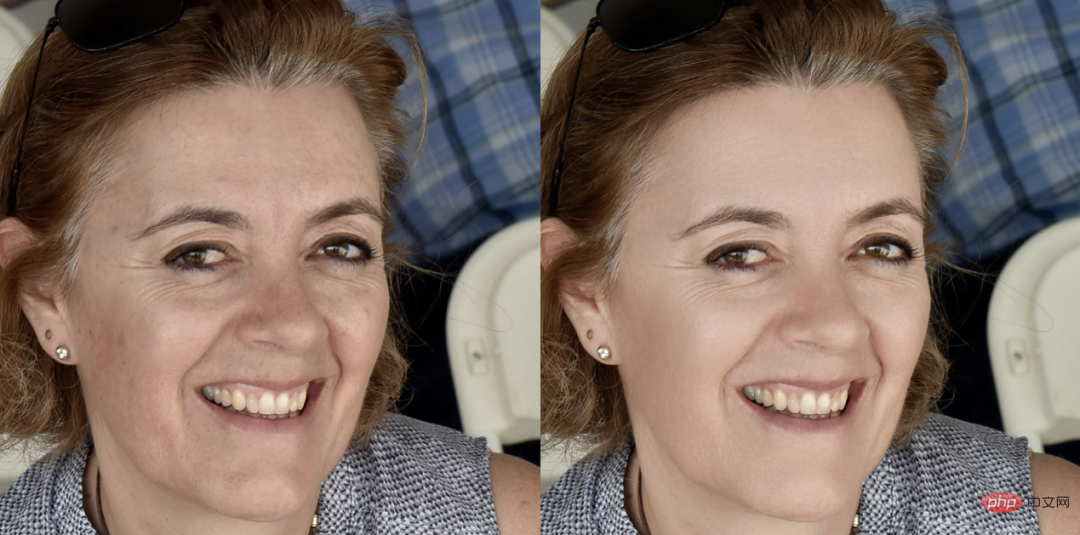
##The original image comes from the face data set FFHQ [32] It can be seen that compared with the traditional beauty algorithm, the local retouching framework we proposed fully retains the texture and texture of the skin while removing skin defects, achieving fine and intelligent Skin texture optimization. Further, we extended this method to the field of clothing wrinkle removal and achieved good results, as follows: 
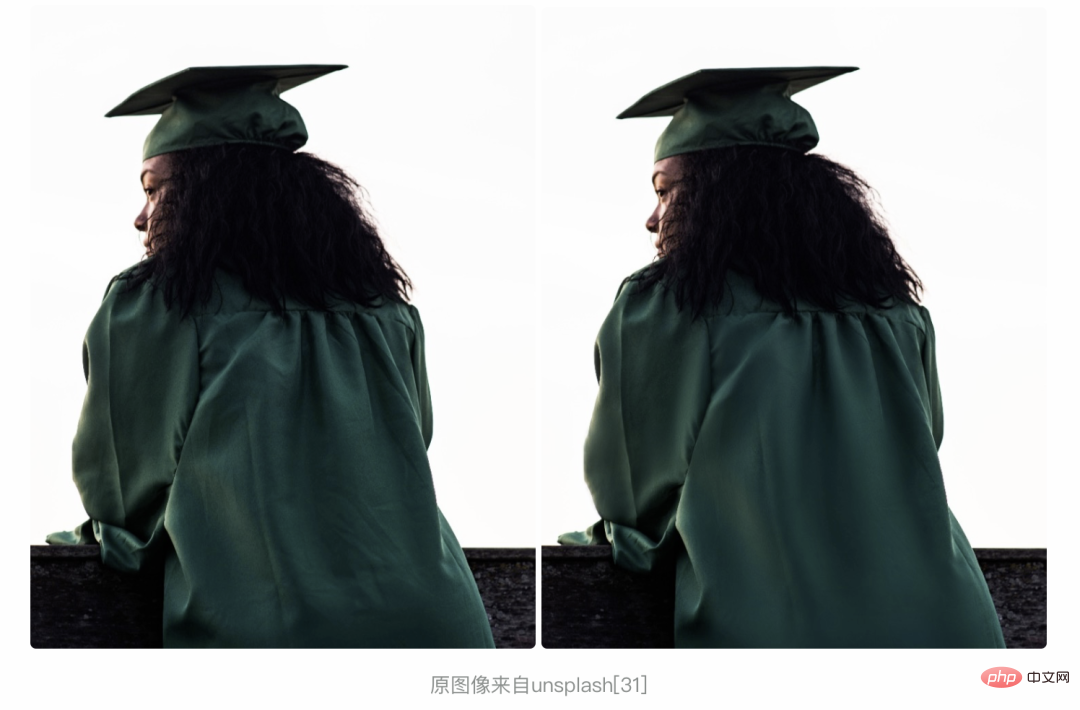
##
The above is the detailed content of Erase blemishes and wrinkles with one click: in-depth interpretation of DAMO Academy's high-definition portrait skin beauty model ABPN. For more information, please follow other related articles on the PHP Chinese website!

Hot AI Tools

Undresser.AI Undress
AI-powered app for creating realistic nude photos

AI Clothes Remover
Online AI tool for removing clothes from photos.

Undress AI Tool
Undress images for free

Clothoff.io
AI clothes remover

Video Face Swap
Swap faces in any video effortlessly with our completely free AI face swap tool!

Hot Article

Hot Tools

Notepad++7.3.1
Easy-to-use and free code editor

SublimeText3 Chinese version
Chinese version, very easy to use

Zend Studio 13.0.1
Powerful PHP integrated development environment

Dreamweaver CS6
Visual web development tools

SublimeText3 Mac version
God-level code editing software (SublimeText3)

Hot Topics
 1664
1664
 14
14
 1423
1423
 52
52
 1318
1318
 25
25
 1269
1269
 29
29
 1248
1248
 24
24
 How to understand DMA operations in C?
Apr 28, 2025 pm 10:09 PM
How to understand DMA operations in C?
Apr 28, 2025 pm 10:09 PM
DMA in C refers to DirectMemoryAccess, a direct memory access technology, allowing hardware devices to directly transmit data to memory without CPU intervention. 1) DMA operation is highly dependent on hardware devices and drivers, and the implementation method varies from system to system. 2) Direct access to memory may bring security risks, and the correctness and security of the code must be ensured. 3) DMA can improve performance, but improper use may lead to degradation of system performance. Through practice and learning, we can master the skills of using DMA and maximize its effectiveness in scenarios such as high-speed data transmission and real-time signal processing.
 How to use the chrono library in C?
Apr 28, 2025 pm 10:18 PM
How to use the chrono library in C?
Apr 28, 2025 pm 10:18 PM
Using the chrono library in C can allow you to control time and time intervals more accurately. Let's explore the charm of this library. C's chrono library is part of the standard library, which provides a modern way to deal with time and time intervals. For programmers who have suffered from time.h and ctime, chrono is undoubtedly a boon. It not only improves the readability and maintainability of the code, but also provides higher accuracy and flexibility. Let's start with the basics. The chrono library mainly includes the following key components: std::chrono::system_clock: represents the system clock, used to obtain the current time. std::chron
 How to measure thread performance in C?
Apr 28, 2025 pm 10:21 PM
How to measure thread performance in C?
Apr 28, 2025 pm 10:21 PM
Measuring thread performance in C can use the timing tools, performance analysis tools, and custom timers in the standard library. 1. Use the library to measure execution time. 2. Use gprof for performance analysis. The steps include adding the -pg option during compilation, running the program to generate a gmon.out file, and generating a performance report. 3. Use Valgrind's Callgrind module to perform more detailed analysis. The steps include running the program to generate the callgrind.out file and viewing the results using kcachegrind. 4. Custom timers can flexibly measure the execution time of a specific code segment. These methods help to fully understand thread performance and optimize code.
 Quantitative Exchange Ranking 2025 Top 10 Recommendations for Digital Currency Quantitative Trading APPs
Apr 30, 2025 pm 07:24 PM
Quantitative Exchange Ranking 2025 Top 10 Recommendations for Digital Currency Quantitative Trading APPs
Apr 30, 2025 pm 07:24 PM
The built-in quantization tools on the exchange include: 1. Binance: Provides Binance Futures quantitative module, low handling fees, and supports AI-assisted transactions. 2. OKX (Ouyi): Supports multi-account management and intelligent order routing, and provides institutional-level risk control. The independent quantitative strategy platforms include: 3. 3Commas: drag-and-drop strategy generator, suitable for multi-platform hedging arbitrage. 4. Quadency: Professional-level algorithm strategy library, supporting customized risk thresholds. 5. Pionex: Built-in 16 preset strategy, low transaction fee. Vertical domain tools include: 6. Cryptohopper: cloud-based quantitative platform, supporting 150 technical indicators. 7. Bitsgap:
 How to handle high DPI display in C?
Apr 28, 2025 pm 09:57 PM
How to handle high DPI display in C?
Apr 28, 2025 pm 09:57 PM
Handling high DPI display in C can be achieved through the following steps: 1) Understand DPI and scaling, use the operating system API to obtain DPI information and adjust the graphics output; 2) Handle cross-platform compatibility, use cross-platform graphics libraries such as SDL or Qt; 3) Perform performance optimization, improve performance through cache, hardware acceleration, and dynamic adjustment of the details level; 4) Solve common problems, such as blurred text and interface elements are too small, and solve by correctly applying DPI scaling.
 What is real-time operating system programming in C?
Apr 28, 2025 pm 10:15 PM
What is real-time operating system programming in C?
Apr 28, 2025 pm 10:15 PM
C performs well in real-time operating system (RTOS) programming, providing efficient execution efficiency and precise time management. 1) C Meet the needs of RTOS through direct operation of hardware resources and efficient memory management. 2) Using object-oriented features, C can design a flexible task scheduling system. 3) C supports efficient interrupt processing, but dynamic memory allocation and exception processing must be avoided to ensure real-time. 4) Template programming and inline functions help in performance optimization. 5) In practical applications, C can be used to implement an efficient logging system.
 Steps to add and delete fields to MySQL tables
Apr 29, 2025 pm 04:15 PM
Steps to add and delete fields to MySQL tables
Apr 29, 2025 pm 04:15 PM
In MySQL, add fields using ALTERTABLEtable_nameADDCOLUMNnew_columnVARCHAR(255)AFTERexisting_column, delete fields using ALTERTABLEtable_nameDROPCOLUMNcolumn_to_drop. When adding fields, you need to specify a location to optimize query performance and data structure; before deleting fields, you need to confirm that the operation is irreversible; modifying table structure using online DDL, backup data, test environment, and low-load time periods is performance optimization and best practice.
 How to use string streams in C?
Apr 28, 2025 pm 09:12 PM
How to use string streams in C?
Apr 28, 2025 pm 09:12 PM
The main steps and precautions for using string streams in C are as follows: 1. Create an output string stream and convert data, such as converting integers into strings. 2. Apply to serialization of complex data structures, such as converting vector into strings. 3. Pay attention to performance issues and avoid frequent use of string streams when processing large amounts of data. You can consider using the append method of std::string. 4. Pay attention to memory management and avoid frequent creation and destruction of string stream objects. You can reuse or use std::stringstream.



